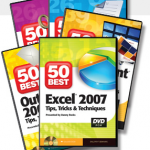MS Excel is the best application for organizing & calculating data. It is also the best choice for creating graphs of your data.
MS PowerPoint is the best application for communicating “the story” that you want your data to communicate.
Use each application to do what it does best. And don’t waste time re-typing your Excel data into PowerPoint.
In this video lesson, I demonstrate 5 ways to import your Excel data into a PowerPoint presentation. 1) Paste it as Text only. 2) Paste it as a Picture. 3) Paste it as a Table. 4) Embed the entire Excel Workbook (OLE). 5) Paste Special to establish a “Link” to the Excel Source Data.
Here are the steps to follow in this video lesson:
- Select and copy the Excel Data to the clipboard.
- In PowerPoint select the slide for the data and choose “Paste.”
- Look at the bottom right corner of the “pasted data” and locate the “Paste Options” tag.
- Option #1 – Paste as Text Only. The data is pasted into a Text box that can me sized and moved.
- Option #2 – Paste a Picture of the Table – Can be sized and moved. The Picture Toolbar makes it easy to modify the background and borders of the table.
- Option #3 – Paste the data as a Table (Default option) – each entry fits into its own “cell” in the table. Easy to format the table to fit your needs.
- Option #4 – Paste the Entire Excel Workbook. This option actually “embeds” the Excel application – and increased the size of you file. You can double-click on the table and the MS Excel application is activated (OLE) so that you can e.g. modify functions and add fields. etc.
- Option #5 – This time you choose Edit – Paste Special – Link. Now, whenever you change the “source data” in Excel your PowerPoint slide will update to reflect the current information. Be careful to keep the Excel file in the same directory as your PowerPoint presentation file so that the “link” does not get lost when you move files to a USB drive or other location.

















